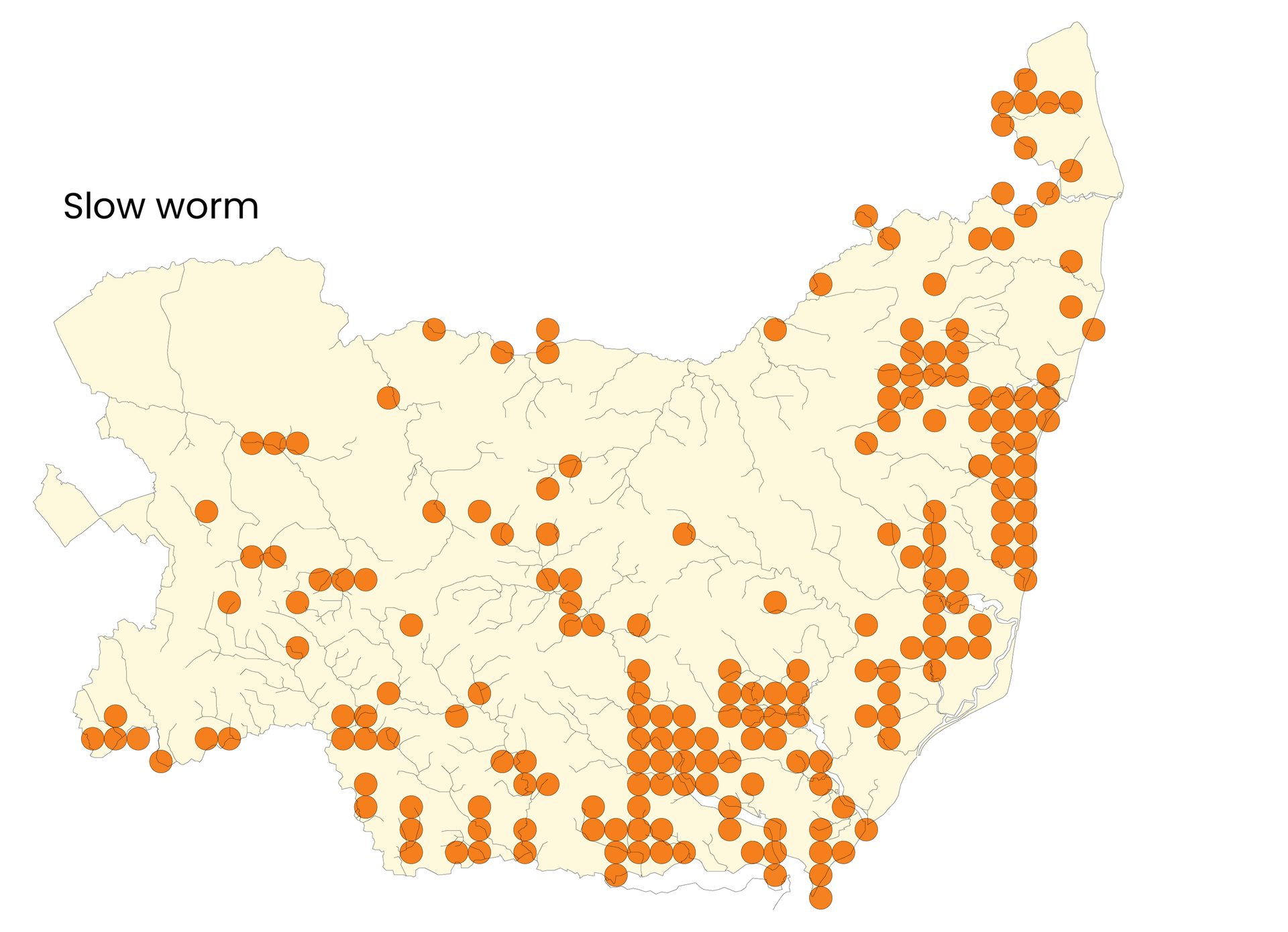Of all the defence tactics Slow worms employ – freezing, fleeing and squirting a foul-smelling substance – the most spectacular is shedding their tail.
However, this is a trick that can only be used once.
Etymology
The Slow worm's Latin name translates as "fragile snake". Anguis means snake, and fragilis is fragile (also related to fragment) after the tail that easily breaks off. They are also known as deaf adders, blindworms ("blind" refers to their small eyes), and, in some areas, long-cripples and hazel worms.
Description
© Margaret W. Carruthers, Flickr
Unlike other reptiles, Slow worms rarely bask in direct sunlight, preferring to raise their body temperature by lying underneath objects or in rotting plant matter such as compost. They are most likely to be seen around dusk when they are actively hunting for food.
Slow worms are semi-fossorial (live above and below ground) and tunnel through loose soil and decaying vegetation.
© Clement Bastie, Flickr
They have long, snake-like bodies without visible necks and can grow to over 55 cm long, however most only reach 40–45 cm.
Their tail has a horny tip and is a continuation of their body. Slow worms demonstrate caudal autotomy (shedding the tail when pulled). Studies have found that most (50–70%) wild Slow worms have lost their tails. Although their tails do regrow, it is a slow process, and their new tail will be much shorter than the original and can't be shed.
At Deneway Nature Reserve, Sussex Wildlife Trust's trail cams caught a Slow worm detaching it's tail to escape from a hungry Magpie.
© Mircea Nita, Flickr
Slow worms bodies are covered in smooth round-to-hexagonal scales that overlap and feel dry to the touch. Under their scales, they have osteoderms (bony plates), which makes their movements appear stiffer and clumsier than snakes.
Female slow worms are dark brown, with dark stripes along their sides and sometimes a thin line along their back. Males are paler brown and sometimes have vivid blue spots during the breeding season and the juveniles are shiny bronze.
© Alexandre Roux, Flickr
Slow worm's ear openings are virtually hidden by their scales. Their eyes, which are small for their body size, have flexible eyelids and round pupils.
Their teeth are pointed and curve backwards. Unlike snakes, they do not have a gap in their upper lip, so they need to open their mouth to extend their tongue to lick or 'scent' the air.
© Urmas Ojango, Flickr
Slow worms have a short bilobed (notched) tongue with blunt tips. They can sense prey and predators by flicking it in and out to 'smell' the air around them. Research has shown that they can distinguish between predatory snakes and harmless species.

Slow worms are found across the UK, except in most Scottish islands, Northern Ireland and most Channel Islands. They are currently listed as a species of 'Least Concern' on the IUCN Red List, but their population is in decline due to habitat loss and fragmentation.
They prefer areas with dense plant cover and are often found in woodland glades, scrubland, pasture, heathland, gardens and similar habitats. However, these habitats are under threat due to urbanization, agriculture, and climate change, which can lead to a decline in their populations. Therefore, it's crucial to understand and mitigate these threats to ensure the survival of Slow worms.
Distribution in Suffolk
Lifecycle
Slow worms are surprisingly long-lived, with the oldest recorded individual being a 54-year-old captive male at Copenhagen Zoo (1892–1946). In the wild, they can be expected to live for 15 to 25 years.
© Olivier Nowakowski, Flickr
Their breeding season begins in May, which can trigger more aggressive male behaviour, fighting over territory and mates. While they rarely bite humans, their teeth have another important use.
The mating process is protracted. Once a male Slow worm has found a willing partner, he bites her head, neck, and back, gripping her tightly in his jaws. Their bodies entwined, they and tumble, roll and writhe together. Their courtship and breeding can take up to 10 hours. As a result of his 'love' bites, older females often have scars from previous breeding seasons.
© Emily, iNaturalist
Carol Murray recorded this pair mating in her garden.
The newborn hatchlings are 7–10 cm long and enclosed in a fragile, transparent eggshell which they immediately break free from.
In October, as winter draws in, Slow worms burrow underground to hibernate, waiting for the warmer weather to return in the spring.
© GreyGeezer, Wikimedia
Diet
Slow worms eat a variety of invertebrates, including slugs, snails, spiders, earthworms, and smaller prey. Their backward-curving teeth are perfect for gripping wriggling or slippery prey.
© Kentish Plumber, Flickr
Slow worm or Snake?
Spotting them
When to see them: March to October.
Please help us to monitor changes in our local population by recording your sightings.
© David Nunn, Flickr

